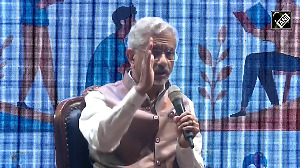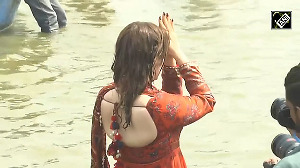As India celebrates its 70th Independence day, Rediff.com pays homage to millions who laid down their lives for the country's freedom.
Scroll down to see some unforgettable moments of the independence movement.
All photographs Courtesy: Photo Division & National Archives

In 1930, Mahatma Gandhi and his 78 assistants embarked on the historic 'Dandi Yatra', the 25-day march on foot to break the salt law. The march was the first act in an even-larger campaign of civil disobedience or satyagraha that Gandhi waged against British rule in India.

Udham Singh (2nd from left) being taken away after the assassination of Michael O'Dwyer who was responsible for the Jalianwala Bagh Massacre. On March 13, 1940, O'Dwyer was scheduled to speak at a joint meeting of the East India Association and the Central Asian Society at Caxton Hall. Singh concealed his revolver in his jacket pocket, entered the hall, and found an open seat. As the meeting concluded, Singh shot O'Dwyer twice as he moved towards the speaking platform, killing him immediately.

On 8 April 1929, revolutionaries Bhagat Singh and Batukeshwar Dutt threw a bomb into the corridors of the Constituent Assembly to show their discontent and frustration against the British government's decision to enact the Trade Disputes Bill and the Public Safety Bill. The revolutionaries surrendered themselves. On June 12, 1929 they were sentenced to Penal transportation for the bombing, having defended the case themselves.

The Quit India movement was launched on August 9, 1942. On August 8, 1942, the All India Congress Committee formally adopted in Bombay a resolution calling on the British to 'Quit India'. The next day, national leaders, including Gandhi, were arrested. From August 9, a spontaneous civil disobedience movement in response to Gandhi's call for immediate independence spread all over the country.

Isolated incidents of violence broke out around the country, but the British acted quickly and arrested thousands of people and kept them in jail till 1945. Apart from filling up jails with rebellious leaders, the British also went ahead and abolished civil rights, freedom of speech and freedom of press.

It was because of the Quit India movement that the British realized that they would not be able to govern India successfully in the long run and began to think of ways they could exit the country in a peaceful and dignified manner. The failure of the Cripps Mission, which the British Government sent to have a dialogue with Indian political parties seeking their support in the war that Britain was waging in Europe, acted as a catalyst to the Quit India Movement.

Although most demonstrations had been suppressed by 1944, upon his release in 1944 Gandhi continued his resistance and went on a 21-day fast. By the end of the Second World War, Britain's place in the world had changed dramatically and the demand for independence could no longer be ignored.

A German-made Mauser pistol used by freedom fighters during the Kakori Train Robbery The Kakori train robbery took place on August 9, 1925, in Uttar Pradesh on a train towards Lucknow that was carrying passengers from central UP. Armed revolutionaries of the Hindustan Republican Association, including Ramprasad Bismil, Ashfaqullah Khan and Chandrashekar Azad, overpowered the train driver and guards and managed to seize the box containing the money (Rs 8,000) being transported from the railway guard’s carriage near Kakori to the government treasury in Lucknow.

Kamla Devi Chattopadhyay and Sarojini Naidu at the Shimla Conference in July, 1945. At the Shimla conference, then Viceroy Archibald Wavell invited leaders of all political parties in India with a view to arrive an agreement of the Wavell plan for Indian self-government. It reached a potential agreement for the self rule in India that provided separate representation to Muslims, and reduced majority powers for both communities in their majority regions. The conference broke down on the insistence of Mohammad Ali Jinnah that his party, the Muslim League, should have an exclusive right to nominate Muslim members of the Viceroy's Executive Council. This was something which the Congress could not concede without repudiating its national composition.

The Cabinet Mission was aimed at seeking an agreement on the constitutional issue with political leaders. Provision was made for three groups of provinces to possess their separate constitutions. The Cabinet Mission also proposed the formation of a Union of India, comprising both the British India and the Princely States. An interim government was to remain in office till a new government was elected on the basis of the new Constitution framed by the Constituent Assembly. Both the Muslim League and the Congress accepted the plan. In the elections held in July 1946, the Congress secured 205 out of 214 General seats. The Muslim League got 73 out of 78 Muslim seats. An interim government was formed under the leadership of Jawaharlal Nehru on September 2, 1946.

Warrant officer Ireland, the caretaker of the Residency in Lucknow, hauling down the British Union Jack at 8pm on August 13, 1947. The flag had been there since 1857.

Lord Mountbatten swearing in Pandit Jawaharlal Nehru as the first Prime Minister of Free India at the ceremony held on August 15, 1947. It was here that Nehru delivered his landmark address "Tryst with Destiny".

British troops departing for the UK were given a very warm send off in Mumbai as well. Mountbatten estimates that there were "several hundreds of thousands" in reception with chants of "England Zindabad" and "Jai England" for, what was till the previous day, a colonial army of occupation. This photograph was taken at the Bombay Docks.

Jawaharlal Nehru, Edwina Mountbatten and Lord Mountbatten watch as the British flag is lowered and the Tricolour unfurled on August 15, 1947. When Lord Mountbatten was asked why he chose August 15 as the day to hand over power to Indians, he replied: "The date I chose came out of the blue. I chose it in reply to a question. I was determined to show I was the master of the whole event. When they asked: had I set a date, I knew it had to be soon. I hadn’t worked it out exactly then -- I thought it had to be about August or September and then I went to the 15th of August. Why? Because it was the second anniversary of Japan’s surrender."

Lord Mountbatten addressing the Independence Day session of the Constituent Assembly on August 15, 1947. Seated at his right is Dr Rajendra Prasad, President of the assembly. Nehru chose 15 other members for his cabinet. Vallabhbhai Patel served as the first deputy Prime Minister until his death on December 15, 1950. Lord Mountbatten, and later C Rajagopalachari served as Governor-General until January 26, 1950, when Rajendra Prasad was elected as the first President of India,

Massive crowds thronged Delhi on August 15 for the ceremonies relating to the transfer of power. The people hailed Gandhi and Nehru, as would be expected, but also, puzzlingly, cheered on Mountbatten as well.











 © 2025
© 2025